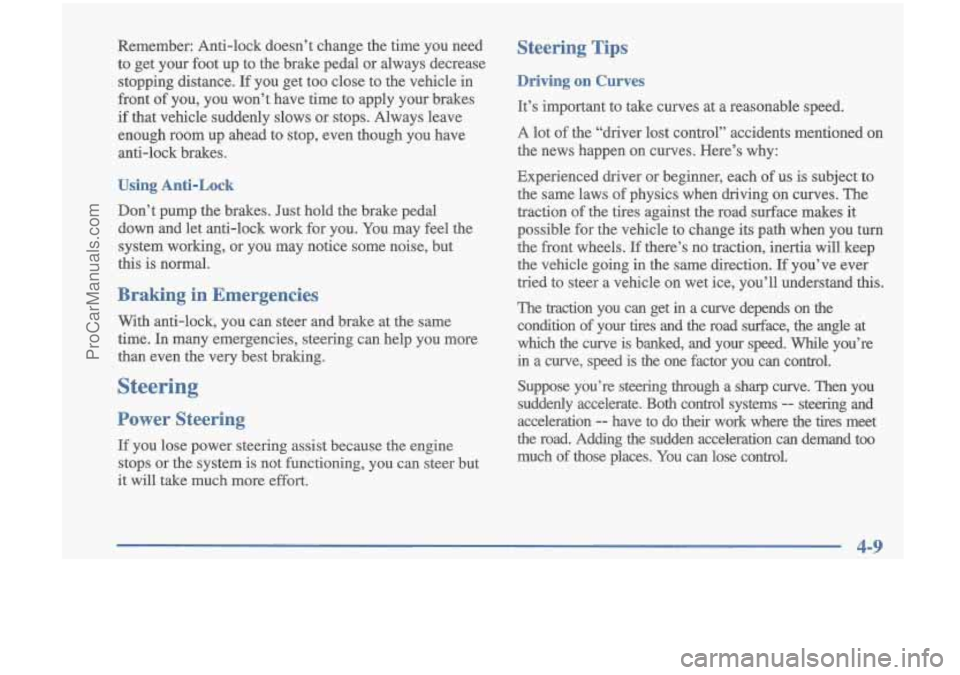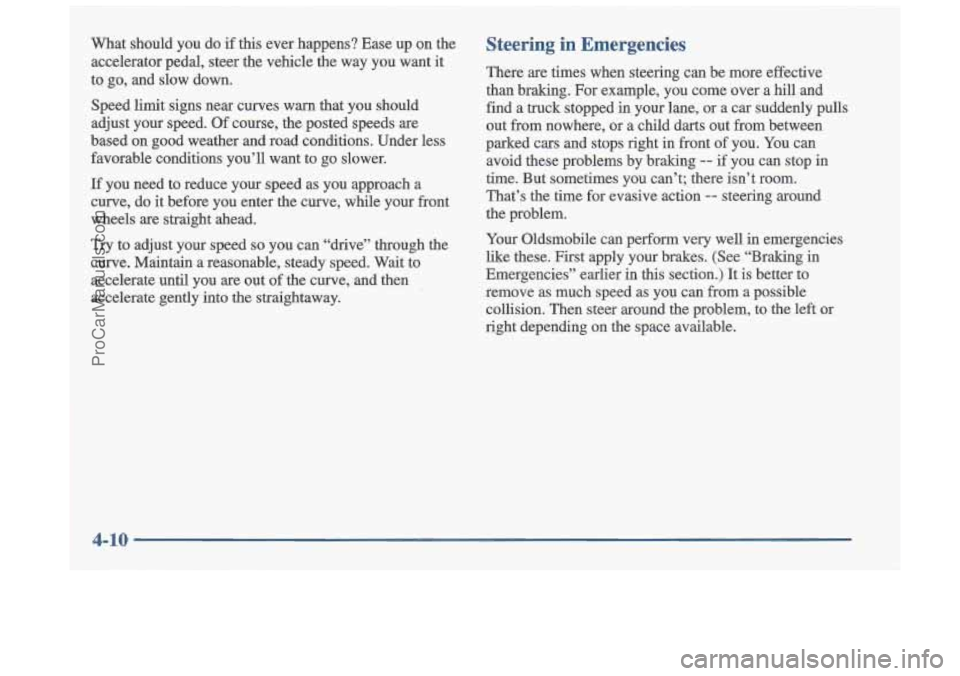Page 84 of 353

Auto-Down Switch
The driver’s window switch has an auto-down feature.
This switch is labeled
AUTO. Push the switch back
partway, and the driver’s window will open a small
amount. If the switch is pushed
all the way back, the
window will go all the way down.
Tilt Wheel
To stop the window while it is lowering, move the
switch forward. To raise the window, move and hold
the switch forward.
Lock Out Switch
The driver’s power window controls also include a
lock out switch. Press LOCK
OUT to stop front and
rear passengers from using their window switches. The
driver can still control all the windows with the lock on.
Press the LOCK
OUT button again for normal window
operation.
Horn
You can sound the horn by pressing the horn symbol on
your steering wheel.
A tilt steering wheel allows you to adjust the steering
wheel before
you drive.
You can also raise it to the highest level to give your
legs more room when you exit and enter the vehicle.
To tilt the wheel, hold the steering wheel and pull the
lever toward you.
Move the steering wheel to a comfortable level, then
release the lever to lock the wheel in place.
2-27
ProCarManuals.com
Page 89 of 353
Cruise Control
Cruise control can be dangerous where you
can’t drive safely at
a steady speed. So,
don’t use your cruise control on winding
roads or in heavy traffic.
slippery roads.
On such roads, fast changes
in tire traction can cause needless wheel
spinning, and you could lose control. Don’t
use cruise control on slippery roads.
Cruise control can be dangerous on
With cruise control, you can maintain
a speed of about
25 mph (40 km/h) or more without keeping your foot
on
the accelerator. This can really help on long trips.
Cruise control does
not work at speeds below
25 mph (40 km/h).
When you apply your brake, the cruise control shuts off.
2-32
ProCarManuals.com
Page 90 of 353

Setting Cruise Control
If you leave your cruise control switch on when
you’re not using cruise, you might
hit a button
and go into cruise when you don’t want to. You
could be startled and even lose control. Keep the
cruise control switch
off until you want to use it.
i
The cruise control buttons are located on the center of
the steering wheel.
1. Press the cruise control ON/OFF button.
2. Get up to the speed you want.
3. Press the SETDECEL button and release it.
4. Take your foot off the accelerator pedal. Resuming
a Set Speed
Suppose you set your cruise control at a desired speed
and then you apply the brake.
This, of course, shuts off
the cruise control. But you don’t need to reset it. Once
you’re going about
25 mph (40 km/h) or more, you can
press the cruise control RESUME/ACCEL button for
about half a second.
You’ll go right back up to your chosen speed and stay there.
If you press the RESUME/ACCEL button longer than half a
second, the vehicle wiU keep
going faster until you release
the switch
or apply the brake. So unless you want to go faster,
don’t hold down the RESUME/ACCEL button.
ProCarManuals.com
Page 94 of 353
Fog Lamps
The button for your fog
lamps is on the instrument
panel, to
the left of the
steering .wheel,
beside
the instrument panel
intensity
control.
.
Interior Lamps
Instrument Panel Intensity Control
ProCarManuals.com
Page 104 of 353
Your instrument panel is designed to let you know at a
glance how your vehicle is running. You’ll know how
fast you’re going, how much fuel you’re using, and
many other things you’ll need to drive safely and
economically.
The main components of your instrument panel are:
A. Fog Lamp Switch
B. Instrument Panel intensity Control
C. Turn SignalMultifunction Lever
D. Cruise Control Switches (If Equipped)
E. Supplemental Restraint System (SRS) and Horn
F. Instrument Panel Cluster
G. Windshield Wipermasher Lever
H. Ignition Switch
J. Hazard Warning Flashers Switch
K. Supplemental Restraint System (SRS)
L. Fuse Panels
M. Climate Control System
N. Accessory Power Outlets
0. Gear Shift Lever
P. Audio System
Q. Park Brake Pedal
R. Tilt Wheel Lever
S. Hood Release Lever
T. Trunk Release Button
U. Instrument Panel Cupholder
2-47
-
ProCarManuals.com
Page 153 of 353
Here’s how anti-lock works. Let’s say the road is wet.
You’re driving safely. Suddenly an animal jumps out
in
front of you.
.You slam on the brakes. Here’s what happens with
ABS.
A computer senses that wheels are slowing down. If one
of the wheels is about to stop rolling, the computer will
separately work the brakes at each front wheel and at the
rear wheels. The anti-lock system can change the brake pressure faster
than any driver could. The computer
is programmed to
make the most of available tire and road conditions.
You can steer around the obstacle while braking hard.
As you brake, your computer keeps receiving updates on
wheel speed and controls braking pressure accordingly.
4-8
ProCarManuals.com
Page 154 of 353

Remember: Anti-lock doesn’t change the time you need
to get your foot up to the brake pedal or always decrease
stopping distance. If you get too close to the vehicle in
front
of you, you won’t have time to apply your brakes
if that vehicle suddenly slows or stops. Always leave
enough room up ahead to stop, even though you have
.anti-lock brakes.
Using Anti-Lock
Don’t pump the brakes. Just hold the brake pedal
down and let anti-lock work for you. You may feel the
system working, or you may notice some noise, but
this
is normal.
Braking in Emergencies
With anti-lock, you can steer and brake at the same
time.
In many emergencies, steering can help you more
than even the very best braking.
Steering
Power Steering
If you lose power steering assist because the engine
stops or the system is not functioning, you can steer but
it will take much more effort.
Steering Tips
Driving on Curves
It’s important to take curves at a reasonable speed.
A lot of the “driver lost control” accidents mentioned on
the news happen on curves. Here’s why:
Experienced driver or beginner, each of us is subject to
the same laws of physics when driving on curves. The
traction of the tires against the road surface makes it
possible for the vehicle to change its path when you
turn
the front wheels. If there’s no traction, inertia will keep
the vehicle going in the same direction. If you’ve ever
tried to steer a vehicle on wet ice, you’ll understand this\
.
The traction you can get
in a curve depends on the
condition
of your tires and the road surface, the angle at
which the curve is banked, and yom speed. While you’re
in a curve, speed is the one factor you can control.
Suppose you’re steering through a sharp curve. Then you
suddenly accelerate. Both control systems
-- steering and
acceleration
-- have to do their work where the tires meet
the road. Adding the sudden acceleration can demand too
much
of those places. You can lose control.
4-9
ProCarManuals.com
Page 155 of 353

What should you do if this ever happens? Ease up on the
accelerator pedal, steer the vehicle the way you want it
to go, and slow down.
Speed limit signs near curves warn that you should
adjust your speed. Of course, the posted speeds
are
based on good weather and road conditions. Under less
favorable conditions you’ll want to go slower.
If you need to reduce your speed as you approach a
curve, do it before you enter the curve, while your front
wheels are straight ahead.
Try to adjust you speed so you can “drive” through the
curve. Maintain a reasonable, steady speed. Wait to
accelerate until you are out of the curve, and then
accelerate gently into the straightaway.
Steering in Emergencies
There are times when steering can be more effective
than braking. For example, you come over a
hill and
find a truck stopped in your lane, or a car suddenly pulls
out from nowhere, or a child darts out from between
parked cars and stops right in front of you. You can
avoid these problems by braking
-- if you can stop in
time. But sometimes you can’t; there isn’t room.
That’s the time for evasive action
-- steering around
the problem.
Your Oldsmobile can perform very well in emergencies
like these. First apply your brakes. (See “Braking in
Emergencies” earlier in this section.) It is better to
remove
as much speed as you can from a possible
collision. Then steer around the problem, to the left or
right depending on the space available.
4-10
ProCarManuals.com